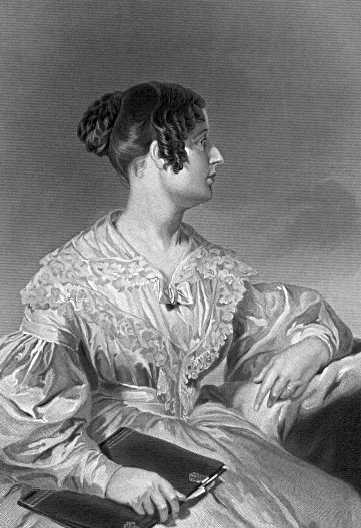- Felicia Hemans
Infobox Writer
name = Felicia Hemans

imagesize = 250px
caption =
pseudonym =
birthdate = September 25th, 1793
birthplace =Liverpool ,England
deathdate = May 16th, 1835
deathplace =Dublin ,Ireland
occupation = Poet
nationality = British
period =
genre =
subject =
movement =
influences =
influenced =
website =Felicia Hemans (
September 25 ,1793 -May 16 1835 ), was an English poet.Early life and works
She was born Felicia Dorothea Browne in
Liverpool , a granddaughter of the Venetian consul in that city. Her father's business soon brought the family to Denbighshire in NorthWales , where she spent her youth. They made their home near Abergele andSt. Asaph (Flintshire), and it is clear that she came to regard herself as Welsh by adoption, later referring to Wales as "Land of my childhood, my home and my dead". Her first poems, dedicated to the Prince of Wales, were published in Liverpool in 1808, when she was only fifteen, arousing the interest of no less a person thanPercy Bysshe Shelley , who briefly corresponded with her. She quickly followed them up with "England and Spain" [1808] and "The domestic affections", published in 1812, the year of her marriage to Captain Alfred Hemans, an Irish army officer some years older than herself. The marriage took her away from Wales, toDaventry inNorthamptonshire until 1814.During their first six years of marriage Felicia gave birth to five sons, including
Charles Isidore Hemans , and then the couple separated. Marriage had not, however, prevented her from continuing her literary career, with several volumes of poetry being published by the respected firm of John Murray in the period after 1816, beginning with "The Restoration of the works of art to Italy" (1816) and "Modern Greece" (1817). "Tales and historic scenes" was the collection which came out in 1819, the year of their separation.Later life
From 1831 onwards, she lived in
Dublin , where her younger brother had settled, and her poetic output continued. Her major collections, including "The Forest Sanctuary" (1825), "Records of Woman" and "Songs of the Affections" (1830) were immensely popular, especially with female readers. Her last books, sacred and profane, are the substantive "Scenes and Hymns of Life" and "National Lyrics, and Songs for Music". She was by now a well-known literary figure, highly regarded by contemporaries such as Wordsworth, and with a popular following in theUnited States and theUnited Kingdom of Great Britain and Ireland . When she died ofdropsy , Wordsworth andWalter Savage Landor composed memorial verses in her honour.Legacy
Felicia Hemans' works appeared in nineteen individual books during her lifetime. After her death in 1835 they were republished widely, usually as collections of individual lyrics and not the longer, annotated works and integrated series that made up her books. For surviving poetesses, like Britons
Caroline Norton andLetitia Elizabeth Landon , AmericansLydia Sigourney andFrances Harper , the FrenchAnable Tastu and GermanAnnette von Droste-Hülshoff , and others, she was a valued model, or (forElizabeth Barrett Browning ) a troubling predecessor; and for male poets includingTennyson andLongfellow , an influence less acknowledged. To many readers she offered a woman's voice confiding a woman's trials; to others a lyricism apparently consonant with Victorian chauvinism and sentimentality. Among the works she valued most were the unfinished "Superstition and Revelation" and the pamphlet "The Sceptic," which sought an Anglicanism more attuned to world religions and women's experiences. In her most successful book, "Records of Woman" (1828), she chronicles the lives of women, both famous and anonymous.Despite her illustrious admirers, if in keeping with her success on the popular marketplace, her stature as a serious poet gradually declined. A jocular reference by Saki in "The Toys of Peace" suggests simultaneously that she was a household word and that Saki did not take her seriously. Schoolchildren in the U. S. were still being taught "The Landing of the Pilgrim Fathers in New England" ("The breaking waves dashed high/On a stern and rock-bound coast...") in the middle of the 20th century. But by the 21st century, "The Stately Homes of England" refers to
Noel Coward 's parody, not to the once-famous poem it parodied, and Felicia Hemans is now remembered popularly for her poem, "Casabianca", and in fact for one line onlyFact|date=November 2007::"The boy stood on the burning deck".However, Hemans has resumed a role in standard anthologies and in classrooms and seminars and literary studies, especially in the U. S. It is likely that further poems will be familiar to new readers, such as "The Image in Lava," "Evening Prayer at a Girls' School," "I Dream of All Things Free," "Night-Blowing Flowers," "Properzia Rossi," "A Spirit's Return," "The Bride of the Greek Isle," "The Wife of Asdrubal," "The Widow of Crescentius," "The Last Song of Sappho," and "Corinne at the Capitol."
Further reading
* "Cambridge Bibliography of English Literature," 3rd ed., 4: 351-60 (2000)
* "Oxford Dictionary of National Biography," 26: 274-77 (2004)
* "Felicia Hemans: Selected Poems, Letters, Reception Materials," ed. Susan J. Wolfson (2000)
* "Felicia Hemans: Selected Poems, Prose, and Letters," ed. Gary Kelly (2002)
* Emma Mason, "Women Poets of the Nineteenth Century" (2006)
* "Felicia Hemans: Reimagining Poetry in the Nineteenth Century," ed. Nanora Sweet & Julie Melnyk (2001)
* Paula Feldman, "The Poet and the Profits: Felicia Hemans and the Literary Marketplace," "Keats-Shelley Journal" 46 (1996): 148-76
* Peter W. Trinder, "Mrs Hemans," U Wales Press (1984)External links
* [http://www.victorianweb.org/authors/hemans/index.html Felicia Hemans at The Victorian Web]
* [http://digital.library.upenn.edu/women/hemans/biography.html Felicia Hemans at A Celebration of Women Writers]
* [http://www.geocities.com/johnhussey1@btinternet.com/felicia.htm] Her life in Liverpool and how she is forgotten in her home city.
* [http://noahcomet.com/ModernGreece.html Complete scanned text of the first edition of "Modern Greece" (1817).]
*
Wikimedia Foundation. 2010.
